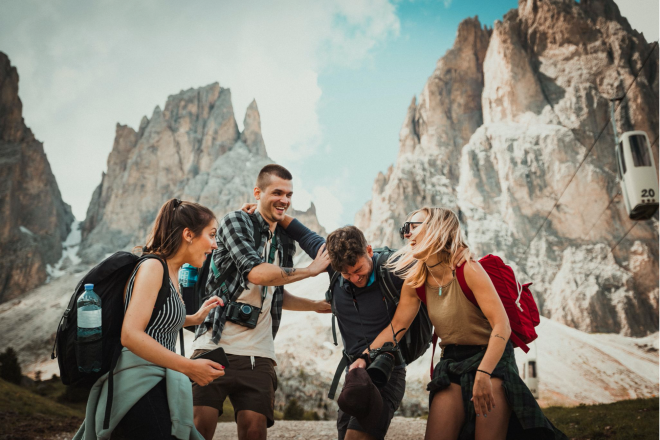
Travelling is a fun activity to do, either for leisure or for professional purposes. The best way to recap and remember your trip is to make a travel video. Wherever you plan to travel – to the countryside, another city, or the beach – capturing your experience in pics and videos is an opportunity you don’t want to miss.
This article is to help you immortalise your trip through the use of a great video maker and one of the best ones available today.
Your Travel Video or Slideshow Format
A film or a video, unlike a slideshow, has many different formats. Slideshows are commonly introduced using continuous slides or images over a particular time, while films can be saved and exported in various video formats.
Film Formats
When creating a film, you must consider what type of video format you prefer. You should know the correct video format you’ll use as it will affect your save process and presentation. You have to make sure that the format you choose is supported by your platform or device where you plan to put your video.
Here are the most common video formats you can save your film as:
- MP4 (MPEG-4 Part 14) – The most popular and commonly used video format nowadays. It’s also one of the earliest digital video formats. With an MP4 configuration, you can create high-quality videos in small file sizes even if they contain still images, audio files, and texts.
- WMV (Windows Media Video) – A Microsoft-designed video format and is generally preferred in Windows media players. It creates small-sized videos better than MP4 and is popularly used for streaming online videos. Take note that this format is not compatible with Apple devices.
- FLV (Flash Video) – A versatile format utilized by Adobe Flash Player. Although it’s relatively small in file size, it isn’t compatible with a lot of mobile devices.
- MOV – Designed by Apple but is compatible with the QuickTime Player in both Mac and Windows systems. However, MOV requires more space in your computer’s memory compared to the first three formats.
- AVCHD (Advanced Video Coding High Definition) – Created by Panasonic and Sony for HD video footage. It lets long, high-quality videos be stored using the MPEG-4 video compression technology.
- AVI (Audio Video Interleave) – A video format that uses less compression than the other formats. Because of this, however, the files are always large and can cause problems for limited storage spaces.
- MKV (Matroska Video file) – An adaptive file format and stores audio, subtitles, and videos altogether.
- WebM – An open-source format intended for HTML5. The codecs of this format need only little computer power to both unzip and compress files.
Preparing for Your Film
Most people prefer making travel videos rather than just slideshows since there are a lot you can store and see with a video. Before making your film, you need first to make sure you’ve prepared everything you’ll need.

Here are a few tips on preparing your video.
Ready Your Video Clips and Recordings
If you don’t have your travel clips yet, make sure you plan out the outline of your clips or photos. Draft how you want your video to play out, so you know what you will shoot. This way, it will be easier for you to organise your shots or clips when editing. It will also depend on what atmosphere you’re going after.
If you already have your clips, check and determine which of them will be included in your final film. Choose what you consider your best clips and pictures from your trip and organise them depending on the order you want them to be in your video.
Choose Your Background Music
Think about what music will be appropriate for your travel theme or which one you prefer to use as your film’s background music. Choose a song that fits the feeling of what’s in the video and what you think will make the viewers feel what you felt when you travelled. You can get music from another source or pick from the available options in the filmmaker you use.
Making a film is always better and more manageable with video creation and editing software. Research on the best software to use based on your skills and experience and what it offers.
One good example of fantastic video creation and editing software is the Movavi Video Suite.
Why Movavi Video Suite?
There are many video editing software available on the internet. But not all of them work the same way Movavi Video Suite does. This suite is a handy tool for creating your travel video.

It’s packed with all tools you’ll ever need to edit, convert videos, and work well with photos and audios. It’s also free to download and offers a watermarked seven-day trial version, so if you’re planning on using it for this one-time video, you don’t need to pay for anything.
Creating and Editing Your Travel Film or Slideshow
Now, there are two ways you can present your travel, in a video or a slideshow. Here are the steps on how to integrate your travel memories in these formats using Movavi Video Suite:
- Gather Everything You Need
Compile all the photos or clips you prepared and want to use. Make sure all of the ones you’ll include show and express your trip the best.
- Open Your Movavi Video Suite
Since you have your files ready, open the software and get started. Create a new project with the suite’s video editor tool by clicking the “New project” button in the “Edit Video” section. You wouldn’t be required to choose a style or a template, and you can quickly and directly start editing your video.
If you’re planning on creating a slideshow, you can go to the “Photo” section on the software and click the “New Project” button under the “Create Slideshows” tool.
- Upload Your Clips or Photos
Start uploading your chosen video clips on the editor by clicking the “Upload” option or by directly dragging and dropping your files on the media tray. To include these clips in your video, drag them again on the storyboard section.
For the slideshow, upload your photos in the same media tray. Movavi uses the same editor for making films and slideshows, so you don’t get confused about the next following steps and instructions.
- Add Additional Video Clips and Effects
There are available sample videos on the software that you can add to your storyboard. Sample videos in Movavi Video Suite include flames, film strips, a clock, a countdown, and more.
You can also add various effects, depending on the theme of your slideshow or video. Some of the suite’s effect packages are Funky Vibes Pack, New York Style Pack, Vlogger Essential Bundle, and even a Horror Intro Pack.
There are also transitions available for you to use for free, like flying objects, light leaks, blurs on the screen, and noise to the video quality.
- Make Adjustments and Transitions
Make the necessary adjustments in the colour of the videos, filters, and many more. Experiment on these and include what you think will make your video better. Transitions make slideshows more dynamic, as well as videos. Since you’re using separate clips and photos, adding transitions to your video will make the transitioning of one clip or photo to another smoother.
- Put Some Text
This is an optional step that you can do to spice up your video. Add text to your project to convey your story better. You can talk about what the particular clip or photo was about. What is your remarkable memory when you watch that clip or see that photo? You can even add the place and time. Include them so that when you watch the video some other time, you can easily remember your trip.
Do this by clicking the “Tt” button in the suite. Different categories, texts, and title formats will appear, and you will be able to choose what you think will suit your video. You can add text using intro videos or simple artistic texts.
- Incorporate Your Background Music
The last element to complete your travel video. Add your chosen song to the video by right-clicking on the storyboard and choosing the “Add Extra Track” and “Add Music Track.” Upload the music and drag it to wherever part of the video you want to hear it.
- Preview Your Edited Video
When you’ve added all the things you want, preview and play what you’ve edited and see if there are necessary edits to do or additional effects to include. Keep editing until you’re satisfied with what you made.
- Export Your Finished Video
The last and final step. If you think there’s nothing more to edit and add to your video, export your project into your preferred video format and save it.
Takeaway
Memories are meant to be kept. Keep your travel moments and memories in a video form and watch them whenever you like to relive the experience. Choosing the best video editing software will help you make this task less daunting and fun.
Remember to follow the steps on how to do a travel video for more accessible editing and creation. Base everything you’ll adjust and add in your video on your preferences and what you think is the best fit for your video’s theme. Watch your video before exporting it to the file format you want to make sure you included everything.





